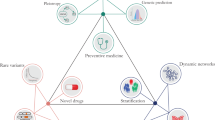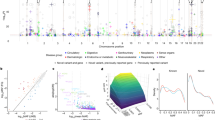Abstract
To explore the contribution of functional coding variants to psoriasis, we analyzed nonsynonymous single-nucleotide variants (SNVs) across the genome by exome sequencing in 781 psoriasis cases and 676 controls and through follow-up validation in 1,326 candidate genes by targeted sequencing in 9,946 psoriasis cases and 9,906 controls from the Chinese population. We discovered two independent missense SNVs in IL23R and GJB2 of low frequency and five common missense SNVs in LCE3D, ERAP1, CARD14 and ZNF816A associated with psoriasis at genome-wide significance. Rare missense SNVs in FUT2 and TARBP1 were also observed with suggestive evidence of association. Single-variant and gene-based association analyses of nonsynonymous SNVs did not identify newly associated genes for psoriasis in the regions subjected to targeted resequencing. This suggests that coding variants in the 1,326 targeted genes contribute only a limited fraction of the overall genetic risk for psoriasis.
This is a preview of subscription content, access via your institution
Access options
Subscribe to this journal
Receive 12 print issues and online access
$209.00 per year
only $17.42 per issue
Buy this article
- Purchase on SpringerLink
- Instant access to full article PDF
Prices may be subject to local taxes which are calculated during checkout

Similar content being viewed by others
References
Zhang, X. Genome-wide association study of skin complex diseases. J. Dermatol. Sci. 66, 89–97 (2012).
Tsoi, L.C. et al. Identification of 15 new psoriasis susceptibility loci highlights the role of innate immunity. Nat. Genet. 44, 1341–1348 (2012).
Liu, Y. et al. A genome-wide association study of psoriasis and psoriatic arthritis identifies new disease loci. PLoS Genet. 4, e1000041 (2008).
Strange, A. et al. A genome-wide association study identifies new psoriasis susceptibility loci and an interaction between HLA-C and ERAP1. Nat. Genet. 42, 985–990 (2010).
Nair, R.P. et al. Genome-wide scan reveals association of psoriasis with IL-23 and NF-κB pathways. Nat. Genet. 41, 199–204 (2009).
Zhang, X.J. et al. Psoriasis genome-wide association study identifies susceptibility variants within LCE gene cluster at 1q21. Nat. Genet. 41, 205–210 (2009).
Ellinghaus, E. et al. Genome-wide association study identifies a psoriasis susceptibility locus at TRAF3IP2. Nat. Genet. 42, 991–995 (2010).
Ellinghaus, E. et al. Genome-wide meta-analysis of psoriatic arthritis identifies susceptibility locus at REL. J. Invest. Dermatol. 132, 1133–1140 (2012).
Stuart, P.E. et al. Genome-wide association analysis identifies three psoriasis susceptibility loci. Nat. Genet. 42, 1000–1004 (2010).
Sun, L.D. et al. Association analyses identify six new psoriasis susceptibility loci in the Chinese population. Nat. Genet. 42, 1005–1009 (2010).
Hüffmeier, U. et al. Common variants at TRAF3IP2 are associated with susceptibility to psoriatic arthritis and psoriasis. Nat. Genet. 42, 996–999 (2010).
Capon, F. et al. Identification of ZNF313/RNF114 as a novel psoriasis susceptibility gene. Hum. Mol. Genet. 17, 1938–1945 (2008).
Ellinghaus, D. et al. Combined analysis of genome-wide association studies for Crohn disease and psoriasis identifies seven shared susceptibility loci. Am. J. Hum. Genet. 90, 636–647 (2012).
Zeggini, E. Next-generation association studies for complex traits. Nat. Genet. 43, 287–288 (2011).
Nejentsev, S., Walker, N., Riches, D., Egholm, M. & Todd, J.A. Rare variants of IFIH1, a gene implicated in antiviral responses, protect against type 1 diabetes. Science 324, 387–389 (2009).
Momozawa, Y. et al. Resequencing of positional candidates identifies low frequency IL23R coding variants protecting against inflammatory bowel disease. Nat. Genet. 43, 43–47 (2011).
Rivas, M.A. et al. Deep resequencing of GWAS loci identifies independent rare variants associated with inflammatory bowel disease. Nat. Genet. 43, 1066–1073 (2011).
Diogo, D. et al. Rare, low-frequency, and common variants in the protein-coding sequence of biological candidate genes from GWASs contribute to risk of rheumatoid arthritis. Am. J. Hum. Genet. 92, 15–27 (2013).
Lesage, S. et al. CARD15/NOD2 mutational analysis and genotype-phenotype correlation in 612 patients with inflammatory bowel disease. Am. J. Hum. Genet. 70, 845–857 (2002).
Jordan, C.T. et al. Rare and common variants in CARD14, encoding an epidermal regulator of NF-κB, in psoriasis. Am. J. Hum. Genet. 90, 796–808 (2012).
Ng, S.B. et al. Exome sequencing identifies the cause of a mendelian disorder. Nat. Genet. 42, 30–35 (2010).
Nair, R.P. et al. Polymorphisms of the IL12B and IL23R genes are associated with psoriasis. J. Invest. Dermatol. 128, 1653–1661 (2008).
Kumar, P., Henikoff, S. & Ng, P.C. Predicting the effects of coding non-synonymous variants on protein function using the SIFT algorithm. Nat. Protoc. 4, 1073–1081 (2009).
Adzhubei, I.A. et al. A method and server for predicting damaging missense mutations. Nat. Methods 7, 248–249 (2010).
Franke, A. et al. Genome-wide meta-analysis increases to 71 the number of confirmed Crohn's disease susceptibility loci. Nat. Genet. 42, 1118–1125 (2010).
Maeda, S. et al. Structure of the connexin 26 gap junction channel at 3.5 Å resolution. Nature 458, 597–602 (2009).
Nguyen, T.T. et al. Structural basis for antigenic peptide precursor processing by the endoplasmic reticulum aminopeptidase ERAP1. Nat. Struct. Mol. Biol. 18, 604–613 (2011).
Kochan, G. et al. Crystal structures of the endoplasmic reticulum aminopeptidase-1 (ERAP1) reveal the molecular basis for N-terminal peptide trimming. Proc. Natl. Acad. Sci. USA 108, 7745–7750 (2011).
Tanaka, T. et al. Genome-wide association study of vitamin B6, vitamin B12, folate, and homocysteine blood concentrations. Am. J. Hum. Genet. 84, 477–482 (2009).
Hazra, A. et al. Common variants of FUT2 are associated with plasma vitamin B12 levels. Nat. Genet. 40, 1160–1162 (2008).
Jordan, C.T. et al. PSORS2 is due to mutations in CARD14. Am. J. Hum. Genet. 90, 784–795 (2012).
Maurano, M.T. et al. Systematic localization of common disease-associated variation in regulatory DNA. Science 337, 1190–1195 (2012).
ENCODE Project Consortium. An integrated encyclopedia of DNA elements in the human genome. Nature 489, 57–74 (2012).
Gerstein, M.B. et al. Architecture of the human regulatory network derived from ENCODE data. Nature 489, 91–100 (2012).
Hunt, K.A. et al. Negligible impact of rare autoimmune-locus coding-region variants on missing heritability. Nature 498, 232–235 (2013).
Manolio, T.A. et al. Finding the missing heritability of complex diseases. Nature 461, 747–753 (2009).
Eichler, E.E. et al. Missing heritability and strategies for finding the underlying causes of complex disease. Nat. Rev. Genet. 11, 446–450 (2010).
Albert, T.J. et al. Direct selection of human genomic loci by microarray hybridization. Nat. Methods 4, 903–905 (2007).
Li, H. & Durbin, R. Fast and accurate long-read alignment with Burrows-Wheeler transform. Bioinformatics 26, 589–595 (2010).
McKenna, A. et al. The Genome Analysis Toolkit: a MapReduce framework for analyzing next-generation DNA sequencing data. Genome Res. 20, 1297–1303 (2010).
Li, R. et al. SNP detection for massively parallel whole-genome resequencing. Genome Res. 19, 1124–1132 (2009).
Wang, K., Li, M. & Hakonarson, H. ANNOVAR: functional annotation of genetic variants from high-throughput sequencing data. Nucleic Acids Res. 38, e164 (2010).
Purcell, S. et al. PLINK: a tool set for whole-genome association and population-based linkage analyses. Am. J. Hum. Genet. 81, 559–575 (2007).
Wallenstein, S. & Wittes, J. The power of the Mantel-Haenszel test for grouped failure time data. Biometrics 49, 1077–1087 (1993).
Barrett, J.C., Fry, B., Maller, J. & Daly, M.J. Haploview: analysis and visualization of LD and haplotype maps. Bioinformatics 21, 263–265 (2005).
Purcell, S., Cherny, S.S. & Sham, P.C. Genetic Power Calculator: design of linkage and association genetic mapping studies of complex traits. Bioinformatics 19, 149–150 (2003).
Siepel, A., Pollard, K. & Haussler, D. in Research in Computational Molecular Biology, Vol. 3909 (eds. Apostolico, A., Guerra, C., Istrail, S., Pevzner, P. & Waterman, M.) 190–205 (Springer, Berlin, Heidelberg, 2006).
Han, F. & Pan, W. A data-adaptive sum test for disease association with multiple common or rare variants. Hum. Hered. 70, 42–54 (2010).
Madsen, B.E. & Browning, S.R. A groupwise association test for rare mutations using a weighted sum statistic. PLoS Genet. 5, e1000384 (2009).
Dering, C., Hemmelmann, C., Pugh, E. & Ziegler, A. Statistical analysis of rare sequence variants: an overview of collapsing methods. Genet. Epidemiol. 35 (suppl. 1), S12–S17 (2011).
Li, B. & Leal, S.M. Methods for detecting associations with rare variants for common diseases: application to analysis of sequence data. Am. J. Hum. Genet. 83, 311–321 (2008).
Wu, M.C. et al. Rare-variant association testing for sequencing data with the sequence kernel association test. Am. J. Hum. Genet. 89, 82–93 (2011).
Price, A.L. et al. Pooled association tests for rare variants in exon-resequencing studies. Am. J. Hum. Genet. 86, 832–838 (2010).
Neale, B.M. et al. Testing for an unusual distribution of rare variants. PLoS Genet. 7, e1001322 (2011).
Acknowledgements
We thank the individuals who participated in this project and their families. We also want to thank L. Wu, D. Li, Y. Shi, J. Shen, L. Song, Y. Xue, J. Jv, Y. Sheng and J. Gao who participated in the analysis of exome sequencing data. We thank the State Key Laboratory Incubation Base of Dermatology, Ministry of National Science and Technology (Hefei, China). This study was funded by the Key Program of the National Natural Science Foundation of China (81130031), the National Science Fund for Excellent Young Scholars (81222022), the Outstanding Talents of Organization Department of the CPC (Communist Party of China) Central Committee program, the Local Universities Characteristics and Advantages of Discipline Development Program of the Ministry of Finance of China and the General Program of the National Natural Science Foundation of China (81072461, 30971644, 31171224, 31000528, 81000692, 81071285, 81172866, 81172591 and 31200939), New Century Excellent Talents in University (NCET-11-0889), and the Science and Technological Fund of Anhui Province for Outstanding Youth (1108085J10) as well as the Pre-National Basic Research Program of China (973 Plan; 2012CB722404), the National Basic Research Program of China (973 Plan; 2009CB825404), the State Key Development Program for Basic Research of China (973 Program; 2011CB809203), the Chinese High-Tech (863) Program (2012AA02A201), the Enterprise Key Laboratory, supported by Guangdong Province, and the Shenzhen Key Laboratory of Transomics Biotechnologies (CXB201108250096A), and the National High-Tech Research & Development Program (2012AA020206).
Author information
Authors and Affiliations
Contributions
Xuejun Zhang conceived this study and obtained financial support. Xuejun Zhang, J.W., Yingrui Li and L.S. participated in study design and were responsible for project management. H.C., Y.Q., Q.C., C.Q., Y.C., F.T., H.L., F. Xiao, J.H., D.S., A.Z., C.Z., X.F., H. Tian, Z.W., F.W., B.Y., B.L., G.W., Y.S., L.D., J.S., T.L., Xiuyun Zhang, Yuzhen Li, C.H., A.X., L.W., Xiaohang Zhao, X.G., J.X., F. Zhang and J.Z. conducted sample selection and data management, undertook recruitment, collected phenotype data, undertook related data handling and calculations, managed recruitment and obtained biological samples. H. Tang, X.J., Yang Li, H.J., X.T., X.Y., J.M., R.W., X. Zuo, Y.Z., X. Yin, H.S., Xia Zhao, F. Xu, Q.L., L.L., H.F., S.H., X.X., Y.R., Q.G., X.W., M.X., L.Y. and R.C. designed the bioinformatics and experimental sections, coordinated the collection, maintained project procedures and performed data analysis. F. Zhou, G.C. and X. Zheng performed genotyping analysis. H. Tang, X.J., X. Zuo, X.T. and H.C. undertook data processing, statistical analysis and bioinformatics investigations. H. Tang, X.J., L.S., X.T., Yang Li and J.L. cowrote the manuscript. All authors contributed to the final version of the manuscript, with Xuejun Zhang, J.W., S.Y., L.S., Yingrui Li, H. Tang, X.J., X.T., H.J. and Yang Li having key roles.
Corresponding authors
Ethics declarations
Competing interests
The authors declare no competing financial interests.
Supplementary information
Supplementary Text and Figures
Supplementary Figures 1–8 and Supplementary Tables 1–6, 10–17 and 19 (PDF 4351 kb)
Supplementary Table 7
742 genes by gene-based analysis from exome sequencing and targeted sequencing data (XLSX 395 kb)
Supplementary Table 8
Targeted sequencing of 565 immune related genes (not included psoriasis GWAS loci) and results of gene-based test (XLSX 222 kb)
Supplementary Table 9
Targeted sequencing of 57 genes in psoriasis GWAS loci and results of gene-based test (XLSX 37 kb)
Supplementary Table 18
Depth and coverage per gene (XLSX 273 kb)
Rights and permissions
About this article
Cite this article
Tang, H., Jin, X., Li, Y. et al. A large-scale screen for coding variants predisposing to psoriasis. Nat Genet 46, 45–50 (2014). https://doi.org/10.1038/ng.2827
Received:
Accepted:
Published:
Issue Date:
DOI: https://doi.org/10.1038/ng.2827



